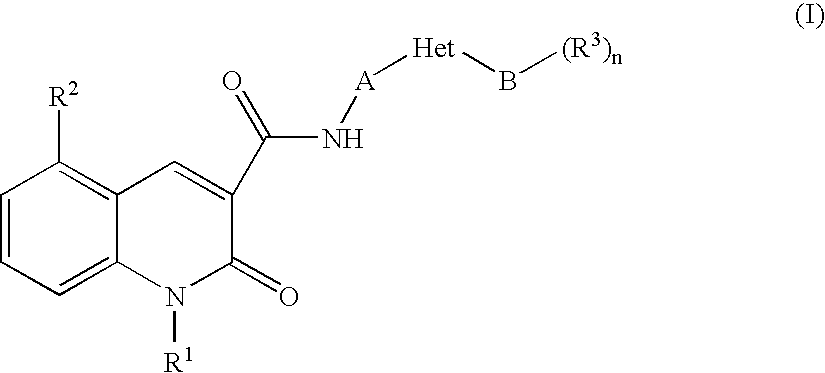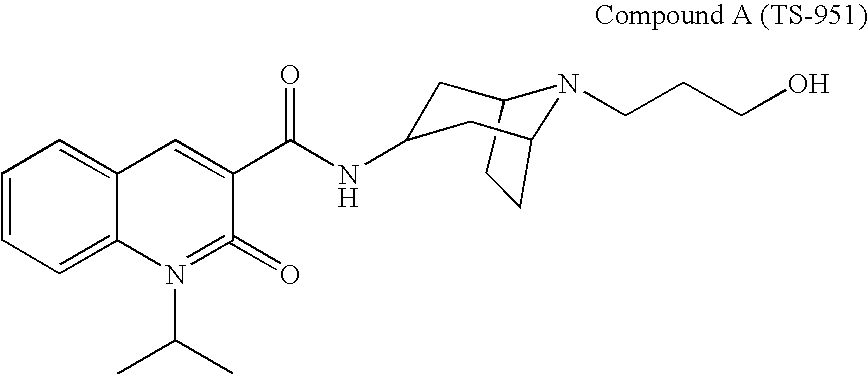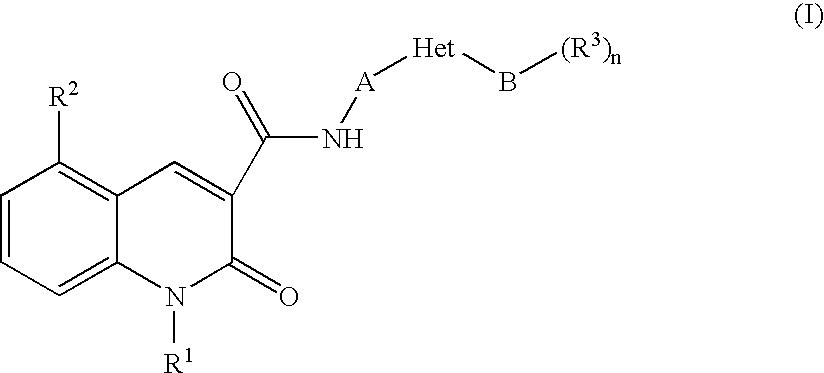Quinolonecarboxylic Acid Compounds Having 5-Ht4 Receptor Agonistic Activity
a technology of quinolonecarboxylic acid and ht4 receptor, which is applied in the field of quinolonecarboxylic acid compounds, can solve the problems of prolongation and the potential liability of producing fatal cardiac arrhythmias, and achieve the effect of strong affinity
- Summary
- Abstract
- Description
- Claims
- Application Information
AI Technical Summary
Benefits of technology
Problems solved by technology
Method used
Image
Examples
example 1
5-CHLORO-N-({1-[(4-HYDROXYTETRAHYDRO-2H-PYRAN4-YL)METHYL]PIPERIDIN-4-YL}METHYL)-1-ISOPROPYL-2-OXO-1,2-DIHIYDROQUINOLINE-3-CARBOXAMIDE
Step 1. Benzyl({1-[(4-hydroxytetrahydro-2H-pyran-4-yl)methyl]piperidin-4-yl}methyl)carbamate
[0111]
[0112]A mixture of benzyl(piperidin-4-ylmethyl)carbamate (7.77 g, 31.3 mmol, Bose, D. Subhas et al., Tetrahedron Lett., 1990, 31, 6903) and 1,6-dioxaspiro[2.5]octane (4.29 g, 37.6 mmol, Satyamurthy, Nagichettiar et al., Phosphorus Sulfur, 1984, 19, 113) in methanol (93 mL) was stirred at room temperature for 20 h. Then the mixture was refluxed for 8 h. After cooling to room temperature, the solvent was removed in vacuo. The residue was chromatographed on a column of silica gel eluting with methanol / dichloromethane (1:20) to give 5.60 g (49%) of the title compound as a colorless oil.
[0113]1H-NMR (CDCl3) δ: 7.40-7.30 (5H, m), 5.09 (2H, s), 4.85 (1H, br), 3.85-3.72 (4H, m), 3.08 (2H, t, J=6.4 Hz), 2.88-2.83 (2H, m), 2.61 (1H, s), 2.36-2.30 (4H, m), 1.77-1.19 ...
example 2
5-CHLORO-N-({1-[(4-HYDROXYTETRAHYDRO-2H-PYRAN-4-YL)METHYL]PIPERIDIN-4-YL}METHYL)-1-ISOPROPYL-2-OXO-1,2-DIHYDROQUINOLINE-3-CARBOXAMIDE ETAHNEDIOATE
[0135]
[0136]A mixture of 5-chloro-N-({1-[(4-hydroxytetrahydro-2H-pyran-4-yl)methyl]piperidin-4-yl}methyl)-1-isopropyl-2-oxo-1,2-dihydroquinoline-3-carboxamide (27 mg, 0.057 mmol, example 1) and oxalic acid (5.2 mg, 0.057 mmol) was dissolved in methanol and stirred for 1 h. The mixture was concentrated and crystallized from diisopropyl ether to give 6.5 mg (20%) of the title compound as a white solid.
[0137]MS (ESI) m / z: 476 (M+H+).
[0138]1H-NMR (DMSO-d6) δ: 9.72 (1H, m), 9.01 (1H, s), 7.90 (1H, d, J=8.8 Hz), 7.70 (1H, dd, J=7.9, 8.8 Hz), 7.54 (1H, d, J=7.7 Hz), 3.70-3.15 (14H, br m), 1.75 (2H, br m), 1.57 (6H, d, J=7.0 Hz), 1.64-1.45 (5H, m).
example 3
N-({1-[(4-HYDROXYTETRAHYDRO-2H-PYRAN4-YL)METHYL]PIPERIDIN-4-YL}METHYL)-1-ISOPROPYL-5-METHYL-2-OXO-1,2-DIHYDROQUINOLINE-3-CARBOXAMIDE
[0139]
[0140]The title compound was prepared according to the procedure of step 3 in the example 1 using 1-isopropyl-5-methyl-2-oxo-1,2-dihydroquinoline-3-carboxylic acid (step 4 in the preparation 2) instead of 5-chloro-1-isopropyl-2-oxo-1,2-dihydroquinoline-3-carboxylic acid.
[0141]MS (ESI) m / z: 456 (M+H+).
[0142]m.p.: 222° C.
[0143]IR (KBr) ν: 3414, 3271, 2926, 2856, 2785, 2742, 1668, 1605, 1587, 1541, 1448, 1380, 1302, 1221, 1153, 1101, 1015, 974, 957, 843, 800, 791 cm−1.
[0144]1H-NMR (CDCl3) δ: 10.04 (1H, br m), 9.13 (1H, s), 7.50 (2H, m), 7.12 (1H, dd, J=4.0, 4.0 Hz), 3.76 (4H, m), 3.37 (2H, t, J=6.3 Hz), 2.88 (2H, d, J=11.7 Hz), 2.67 (3H, m), 2.36 (2H, t, J=11.7 Hz), 2.31 (2H, s), 1.76 (2H, m), 1.67 (6H, d, J=7.0 Hz), 1.65-1.30 (7H, m). Signals due to CH(CH3)2 and OH was not observed.
[0145]Anal. Calcd. for C26H37N3O4.0.2H2O: C, 68.01; H, 8.21; N, 9.15...
PUM
| Property | Measurement | Unit |
|---|---|---|
| temperature | aaaaa | aaaaa |
| temperature | aaaaa | aaaaa |
| temperature | aaaaa | aaaaa |
Abstract
Description
Claims
Application Information
 Login to View More
Login to View More - R&D
- Intellectual Property
- Life Sciences
- Materials
- Tech Scout
- Unparalleled Data Quality
- Higher Quality Content
- 60% Fewer Hallucinations
Browse by: Latest US Patents, China's latest patents, Technical Efficacy Thesaurus, Application Domain, Technology Topic, Popular Technical Reports.
© 2025 PatSnap. All rights reserved.Legal|Privacy policy|Modern Slavery Act Transparency Statement|Sitemap|About US| Contact US: help@patsnap.com



